What Is A Hack Squat? Here\u2019s What You Need To Know
Whether you’re a weight room regular or a home workout warrior, squats are probably a regular part of your routine. And they should be! Squats offer a huge range of benefits, strengthening your lower body (think quads, glutes, and hamstrings) and core in one swoop. Squats are crazy effective at building muscle and revving your metabolism—and you can mix ’em up with all sorts of variations, from goblet squats to…hack squats.
Kory Flores, CPT, a trainer at boxing studio Rumble, breaks squats down into four categories: free weight (think dumbbells or kettlebells), barbell, machine, and bodyweight. You can use these different modalities to distribute the load of your squats differently so that they emphasize certain parts of your body (like your quads or lats), she explains. A goblet squat that you perform holding a kettlebell, for example, requires more work from your back and core than a suitcase squat, which you do holding dumbbells at your sides.
In the gym, one of the most popular squat variations you’ll see people doing on leg day is the hack squat. This machine squat may look a little intimidating, but it can help you load up those legs without having to worry about balance like you might with free-weight squats, Flores says.
Whether you want to build the strongest legs possible or just need to mix up your usual gym routine (hey, been there!), the hack squat machine can help you make workout magic happen. Here, fitness pros break down what to know about this weight room machine, how it can boost your squat strength, and how to use it for big-time results.
What is a hack squat, exactly?
The hack squat machine features an angled platform that you stand on and a moveable backrest with shoulder pads and handles that slide up and down a track as you squat. You’ll add weight to racks attached to the back and shoulder pads and press through your feet, working your glutes, hamstrings, calves, and hip flexors to push the weights along the track as you squat and stand. On most hack squat machines, your feet are positioned at a 45-degree angle, so your body is positioned to be leaning back slightly.
How are hack squats different from regular squats?
While regular squats often involve holding and balancing some sort of weight (like dumbbells or a barbell), the hack squat machine takes stability out of the equation, says trainer Kehinde Anjorin, CFSC, NCSF, creator of The Power Method. Since you’re pushing the weight up and down the machine’s fixed track while resting your back and shoulders on the pads, you’ll primarily work your lower body and don’t need as much core engagement or upper-body stability as you’d need during a free-standing squat.
That said, hack squats are most similar to barbell front squats because the load is distributed more to the front of your body, meaning they put extra emphasis on your quads, Anjorin says.
What are the benefits of hack squats?
Though the core and upper-body required in standard squats are two of their biggest benefits, the more fixed, stable movement of hack squats does come with perks.
“Since a hack squat is performed using a machine, it requires very minimal coaching cues or technique,” says Anjorin. For that reason, hack squats are great for beginners looking to kickstart building strength. The machine allows very little room for error, so squat newbies can focus on training their legs without worrying about maintaining their core and overall stability, she explains.
Hack squats are great for beginners looking to kickstart building strength.
This more-stable movement pattern also means you can go heavier with the move. “By removing the instability of a barbell or dumbbells, you can lift more [weight],” Flores says. This is especially true if limited grip strength is holding you back from working with heavier weights.
“It’s also an opportunity to test out a heavy weight before transitioning to a barbell squat,” she adds. You can thank a combo of the built-in upper body support and the slightly-reclined angle of the hack squat machine for making this possible.
How To Perform A Hack Squat
Sold on the hack squat’s benefits—but not quite sure what to do when you actually step up to the machine? Allow Anjorin to break it down for you:
You can incorporate hack squats into your workout just as you’d mix in any other squat variation. That said, if your number-one priority is to use hack squats to build muscle, Anjorin recommends doing three sets of 10 to 12 reps.
Is there anyone who shouldn’t do hack squats?
Though hack squats are beginner-friendly, they’re not for everyone. “If you have any lower back pain or knee pain, I would not recommend hack squats, as they put a higher amount of strain on your joints,” says Flores.
The bottom line: Hack squats are performed on a machine, and they involve less core and upper-body work than traditional squats and place more emphasis on your lower body, especially your quads.
Source: Read Full Article




